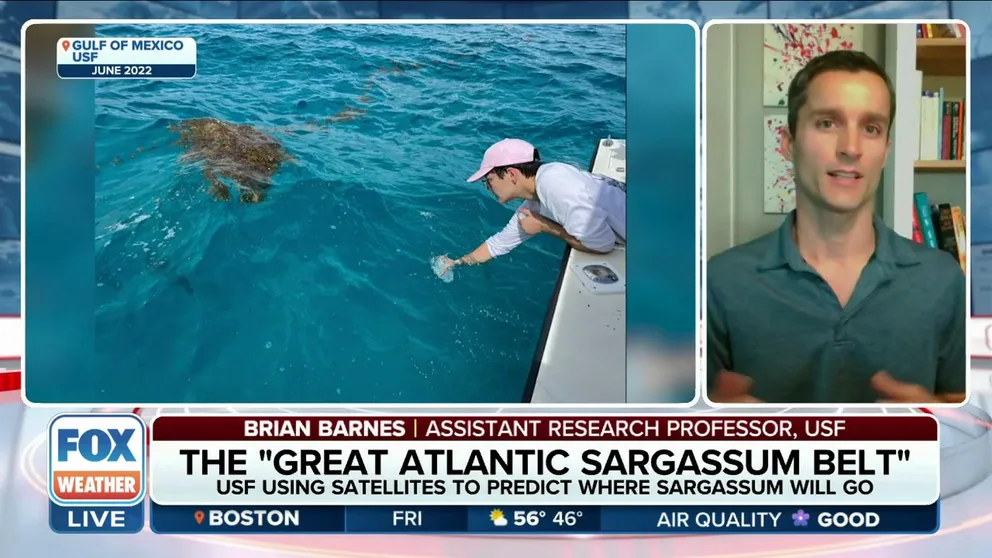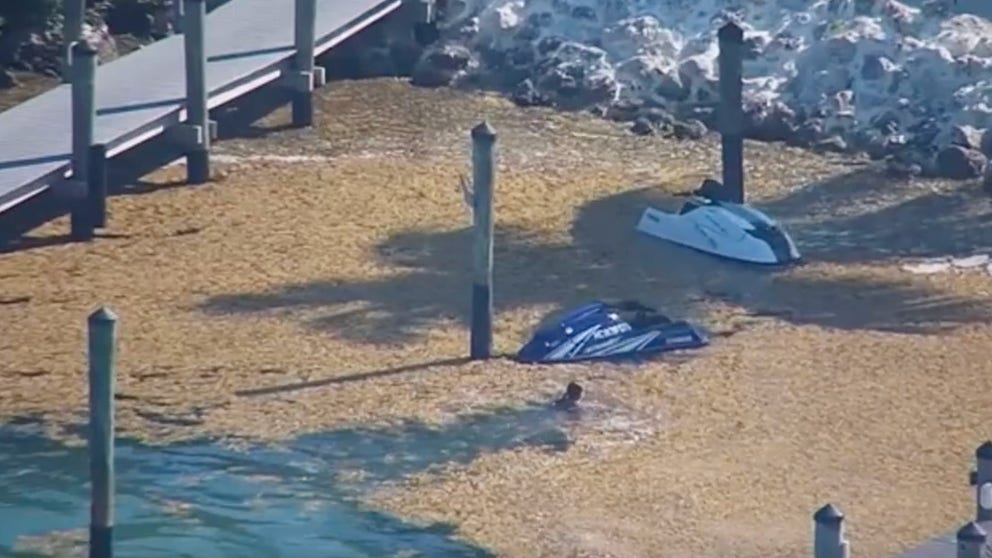Sargassum seaweed 2024 forecast: When could it wash up on US beaches?
According to the University of South Florida Optical Oceanography Lab, roughly 5.5 million metric tons of sargassum seaweed was detected in the central Atlantic Ocean in January, which is a slight increase from what was observed in December 2023.
University of South Florida developing sargassum forecasting system
Dr. Brian Barnes of the University of South Florida joined FOX Weather on Friday to explain how they're developing a system to track sargassum and attempt to predict where it's going next. (Video from November 2023)
TAMPA, Fla. – We’re getting closer to warmer days that include trips to the beach to lay under the warm sun, but it may not be only students on spring break or families on summer vacation in 2024 that will be in the water. A large blob of sargassum seaweed is lurking in the central Atlantic Ocean, and it’s growing in size.
According to the University of South Florida Optical Oceanography Lab, roughly 5.5 million metric tons of sargassum seaweed were detected in the central Atlantic Ocean in January, which is a slight increase from what was observed in December 2023.
FLORIDA RESEARCHERS DEVELOPING SYSTEM TO FORECAST WHERE SMELLY SARGASSUM SEAWEED IS HEADED
Sargassum seaweed invades the Florida Keys
In the Florida Keys, a record bloom of sargassum seaweed continues drifting into lagoons and marinas and piling on beaches. (Video from April 2023)
"Even though this increase is less robust than the change from November to December, the current sargassum abundance remains quite high for the month of January - only surpassed by the quantities in January 2018 and January 2023," researchers said in a news release.
When sargassum is floating in the open waters of the ocean, it doesn't pose too much of a threat. In fact, the National Oceanic and Atmospheric Administration (NOAA) says the floating clumps of brown seaweed are a habitat that provides food and shelter and acts as a breeding ground for several types of animals, including fish, sea turtles, marine birds, crabs and shrimp.
And some animals, like the sargassum fish, live only in that habitat.
Where is sargassum seaweed right now?
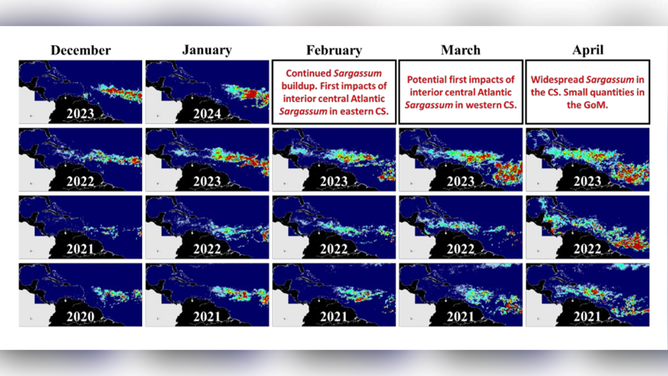
This image shows the current and previous locations of sargassum seaweed.
(University of South Florida Optical Oceanography Laboratory / FOX Weather)
Researchers said that the largest concentrations of sargassum seaweed are still mostly found in the central Atlantic basin, but it has been advancing to the west over the past several months.
And small batches have already started approaching the Lesser Antilles, while a larger batch is still a few hundred miles to the east.
In addition, researchers said clusters of short-lived sargassum patches were also spotted off northeastern portions of South America.
The researchers also said that there has been "essentially no sargassum" observed in the Gulf of Mexico and the Caribbean Sea over the past three months.
HOW FLORIDA'S SARGASSUM SEAWEED BLOB MAY IMPACT SEA TURTLES DURING NESTING SEASON
When will sargassum seaweed wash up on shore in 2024?

FILE - Miami Beach, Florida, North Beach Atlantic Ocean shoreline, large quantity of arriving seaweed sargassum macroalgae, man looking at piles. (Photo by: Jeffrey Greenberg/Universal Images Group via Getty Images)
(Getty Images)
Researchers say that sargassum growth is expected to continue over the next few months as the main bloom in the ocean expands and drifts off to the west.
Some sargassum will likely begin to wash up on shore in the eastern Caribbean Sea beginning later in February or early March.
What’s different from last year, however, is that the southeastern coast of Florida and the Florida Keys will likely remain free of sargassum until at least April or May.
"We will continue to monitor and track sargassum throughout the central Atlantic, and will provide more summary updates at the end of each month."
Current and previous monthly updates, including images, can be found on the Sargassum Watch System (SaWS) website.
Is sargassum seaweed dangerous?
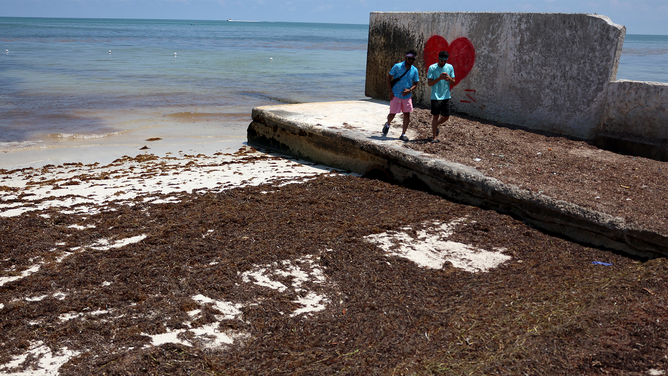
FILE - People walk past a beach covered with sargassum on May 18, 2023 in Key West, Florida. (Photo by Joe Raedle/Getty Images)
(Getty Images)
Problems arise when the sargassum washes ashore.
"After a couple of days onshore, Sargassum starts to decompose and release notorious and stinking gases such as ammonia and hydrogen sulfide, both of which are pollutants to air and water," said Dr. Yuyuan Xie, of the University of South Florida. "Once those pollutants are accumulated in the aquatic environment and reach the concentrations above thresholds, they are poisonous to most fish."
The gasses can also cause respiratory problems for beachgoers, along with rashes and blisters if touched without gloves.
FLESH-EATING BACTERIA, PLASTICS IN SARGASSUM MAY POSE ‘TRIPLE THREAT’ TO PUBLIC HEALTH
Smelly sargassum seaweed invades U.S. beaches
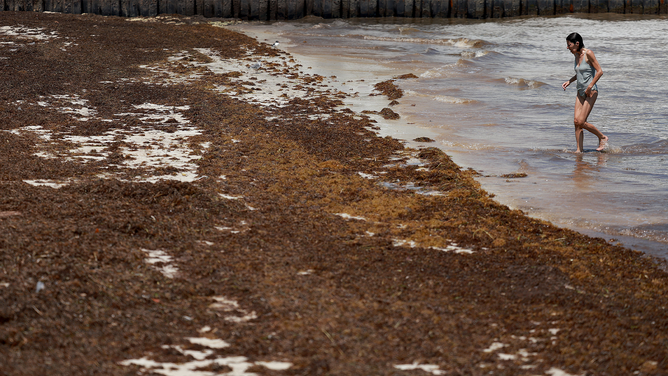
FILE - A beachgoer walks through sargassum that washed ashore on May 18, 2023 in Key West, Florida. (Photo by Joe Raedle/Getty Images)
(Getty Images)
A record-breaking 13-million-ton mass of sargassum seaweed was detected floating across the Atlantic Ocean during the spring of 2023, and although historic levels were forecast to continue, data obtained during the summer months showed a decrease in sargassum seaweed levels.
'SURPRISE' DROP IN SARGASSUM SEAWEED FOR FIRST TIME IN OVER A DECADE, SATELLITE DATA SHOWS
The seaweed still piled up on beaches from the Gulf of Mexico to the Atlantic Ocean, making those summertime trips to the beach less ideal.
2023 ranked among some of the worst sargassum seaweed seasons, even with the decreasing levels from spring to summer.
